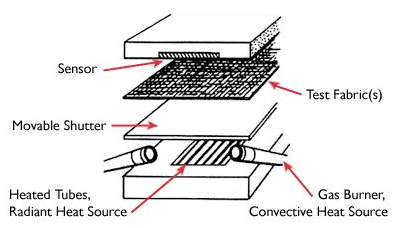
NewsInformation Center
Test Illustration of Thermal Protective Performance Tester
2017/10/23
In the 1986 revision of NFPA 1971, Protective Clothing for Structural Fire Fighting, a new test method for measuring thermal protection was introduced and a minimum thermal protective performance (TPP) rating was established.
This sophisticated test method replaced the requirement for a minimum composite thickness, and its purpose is to measure the rate at which convective and radiant heat penetrate through the composite system – outer shell, thermal liner, and moisture barrier – to cause second-degree burns to the human skin.

This illustration is of a standard TPP tester. The three layers that make up the turnout ensemble are placed in composite form beneath the sensor, which records skin temperature. These layers are placed onto the machine in the same order in which they are found in the protective system, with the thermal layer next to the sensor, the moisture barrier in the middle, and the outer shell next to the energy source.
The movable shutter enables the technician to control the time and the amount of exposure, during which gas burners provide actual flame. At the same time, the heated tubes provide radiant heat and a flashover situation can be simulated.
The point at which heat transfer through all three layers is enough to cause a second-degree burn is determined graphically, by using a recorder chart of the sensor readings. During testing, the recording continuously traces the average temperature rise on paper, which is depicted as a curved line representing higher and higher temperatures as more heat penetrates through the sample materials to the sensor.
As the test is being run, the tracing is compared with a second curve, called the Stoll's curve, which shows the blister point of human skin as a function of heat and time. The point of intersection between these two curves is the actual TPP rating. For the purpose of measuring actual time to burn, the TPP rating is divided in half to determine the number of seconds until human tissue reaches the second-degree burn point. Thus, the NFPA minimum requirement of a TPP rating of 35 equates to 17 1/2 seconds until second-degree burns occur in a flashover situation.
Source: standard group (Hong Kong) limited
This sophisticated test method replaced the requirement for a minimum composite thickness, and its purpose is to measure the rate at which convective and radiant heat penetrate through the composite system – outer shell, thermal liner, and moisture barrier – to cause second-degree burns to the human skin.

This illustration is of a standard TPP tester. The three layers that make up the turnout ensemble are placed in composite form beneath the sensor, which records skin temperature. These layers are placed onto the machine in the same order in which they are found in the protective system, with the thermal layer next to the sensor, the moisture barrier in the middle, and the outer shell next to the energy source.
The movable shutter enables the technician to control the time and the amount of exposure, during which gas burners provide actual flame. At the same time, the heated tubes provide radiant heat and a flashover situation can be simulated.
The point at which heat transfer through all three layers is enough to cause a second-degree burn is determined graphically, by using a recorder chart of the sensor readings. During testing, the recording continuously traces the average temperature rise on paper, which is depicted as a curved line representing higher and higher temperatures as more heat penetrates through the sample materials to the sensor.
As the test is being run, the tracing is compared with a second curve, called the Stoll's curve, which shows the blister point of human skin as a function of heat and time. The point of intersection between these two curves is the actual TPP rating. For the purpose of measuring actual time to burn, the TPP rating is divided in half to determine the number of seconds until human tissue reaches the second-degree burn point. Thus, the NFPA minimum requirement of a TPP rating of 35 equates to 17 1/2 seconds until second-degree burns occur in a flashover situation.
Source: standard group (Hong Kong) limited
Previous: Test Procedure Of Limiting Oxygen Index
N e x t : What is TPP and HTP?



